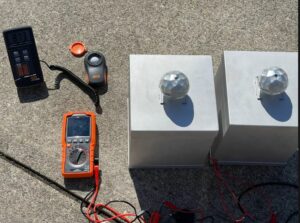New York-based tech company Wavja says the third generation of its proprietary Photon Energy System (PES), which employs tiny spheres to collect photonic energy, generates over 60 times the output of similarly sized traditional solar panels. According to a new video released by the company, the next generation of the PES could soon be powerful enough to run an electric car without a battery.
The company makes several extravagant claims about its system, including that it can allegedly capture light energy from artificial sources, including LED lighting, and convert it to usable electricity, offering both indoor and outdoor applications.
“Our system generates remarkable luminosity by utilizing multiple layers of cutting-edge materials and specialized spheres,” Shereen Chen, co-founder and executive director of Wavja USA, claims in the recently posted video. “This luminosity is then seamlessly converted to electricity using our proprietary technology.”
“It revolutionizes how we harvest sunlight,” Chen adds.


Proprietary Technology Powers Photon Energy System
In the newly released video, Chen explains that the spheres work by capturing the incoming photons from various light sources and converting them into “remarkable luminosity.” This luminosity, a.k.a. light, is then converted to usable electricity using a “proprietary technology. On the company’s website, this element of the technology is referred to as a “silicon conductor module.” However, no other details about the system’s proprietary process are revealed.
After setting aside how the technology itself works, the company also makes some bold claims about the Photon Energy System’s ability to generate significantly more power than traditional solar panels. For example, Chen notes that their first generation of PES spheres, which have operated as the company’s “proof of concept,” generate 7.5 times more energy than similarly sized solar panels.
That number, Chen explains, grew to 20 times in their third generation. According to the company’s website, yet another generation of the PES “is being tested and developed to reach up to 100 times (solar panel power output).”


As for performance, the company says the photonic energy-collecting spheres are not only more powerful than solar panels, but they take up much less space and generate energy much more efficiently than their bulky competitors.
“Compared to traditional solar panels of today, PES is nearly 30 times smaller,” Chen explains, “and it is over 200 times more efficient.”
Based on the limited information provided by Wavja, it appears that much of this increased efficiency is gained by the system’s ability to work for longer hours and in much more varied lighting conditions than solar panels. For example, the company says that traditional solar panels often only have a working time of about two hours due to lighting and other weather conditions. Conversely, they say that “regardless of weather,” their PES “can operate for 8 hours.”
“Its most significant attribute is its capability to utilize artificial light, including LED flashlights,” the company also adds, something they say increases the system’s overall efficiency and potential applications.


Company Claims PES Could Power Vehicles of the Future without the Need for Batteries
Perhaps Wavja’s boldest claims concern its system’s purported ability to power futuristic vehicles like air taxis, boats, cars, and even long-haul electric trucks. While solar panels can accomplish most of the same feats, they must capture and store electricity over a long period of time to generate enough power to fly a drone or power a land vehicle.
In the case of PES, the company says it doesn’t need a battery to power even large vehicles. Instead, it says its system can deliver enough constant energy to power these types of power-hungry applications and operate independently of a battery.
“PES is not connected to a battery,” Chen explains, “PES is actually a separate battery system.”
In the video, Chen shows one such current effort by Wavja to use their system to power a fully electric vehicle. “You are actually looking at real-time, current proof of concept that we are working on,” Chen says.
However, no further details on this effort are provided either, adding to the frustrating number of claims offered by the company that do not seem to be supported with additional data.


The company says it will offer three separate classes of sphere arrays to provide such significant amounts of power. The first, composed of 3cm diameter spheres, is “primarily responsible for mobile equipment.” According to the website, this includes electric locomotives, electric vehicles, flying cars, drones, unmanned taxis, tourist RVs, transportation vehicles, and others. Notably, the company says nine PES systems are needed “to form an array combination for electric vehicles.”


The second class of PES is comprised of 6cm spheres. According to Wavja, this class is mostly planned for larger-scale uses like residential homes, intelligent buildings, public transportation, “water villas,” resorts, heavy trucks, airplanes, seaplanes, electric flying buses, yachts, and “surface scuba diving.” According to Chen, one dream use of the PES is powering automated air cargo drones.


The last and largest category of spheres offered is 10cm in diameter. According to the company, photon energy-collecting spheres of this size can power industrial plants, commercial buildings, science and technology parks, desalination plants, garbage factories, power plants, restaurants, amusement parks, “and so on.”
One potentially novel application hinted at on the company’s website is an aerial fire extinguisher drone powered by its PES. While few details are offered, the company says, “Our proposed AI drone PES fire extinguishing (system) can patrol forests for extended periods of time and extinguish fires promptly upon discovery.”
However, not everyone is so convinced by the company’s claims. Several postings online that include feedback from Reddit users convey many people’s suspicions that the technology is simply too good to be true.
“Extraordinary claims require extraordinary evidence,” one Reddit user identified as customdemo wrote on a thread discussing the technology, mirroring the sentiments of others who voiced concerns that about the legitimacy of some of the company’s claims.
Wavja Aiming to Create More Powerful, More Sustainable Power Generation
Amid the mixed feedback currently appearing online and while the PES spheres are not yet available for the everyday consumer, the company has said it is looking for industry partners to help it bring its purportedly revolutionary power generation system to the worldwide market.
In the meantime, Wavja, which says its name comes from a term that signifies “WOW” in its Latin root and reflects “the company’s commitment to groundbreaking advancements and transformative initiatives,” is continuing to improve the performance of its photonic energy systems. The goal, the company says, is to create a powerful and versatile photon energy power generating system with a vast array of potential applications that could not only revolutionize energy collection and power generation across a number of industries but do so in a cleaner, more sustainable fashion.
“PES can be used on Smart devices, drones, and electric vehicles and are capable of providing long-term power without charging to residential buildings, commercial centers, industrial plants, power grids, waste disposal, and utilities,” they explain. “The aim is to ensure that it doesn’t pollute the environment, all materials are recyclable, and it’s a new clean energy source.”
This article was updated on July 15, 2024.
Christopher Plain is a Science Fiction and Fantasy novelist and Head Science Writer at The Debrief. Follow and connect with him on X, learn about his books at plainfiction.com, or email him directly at christopher@thedebrief.org.

